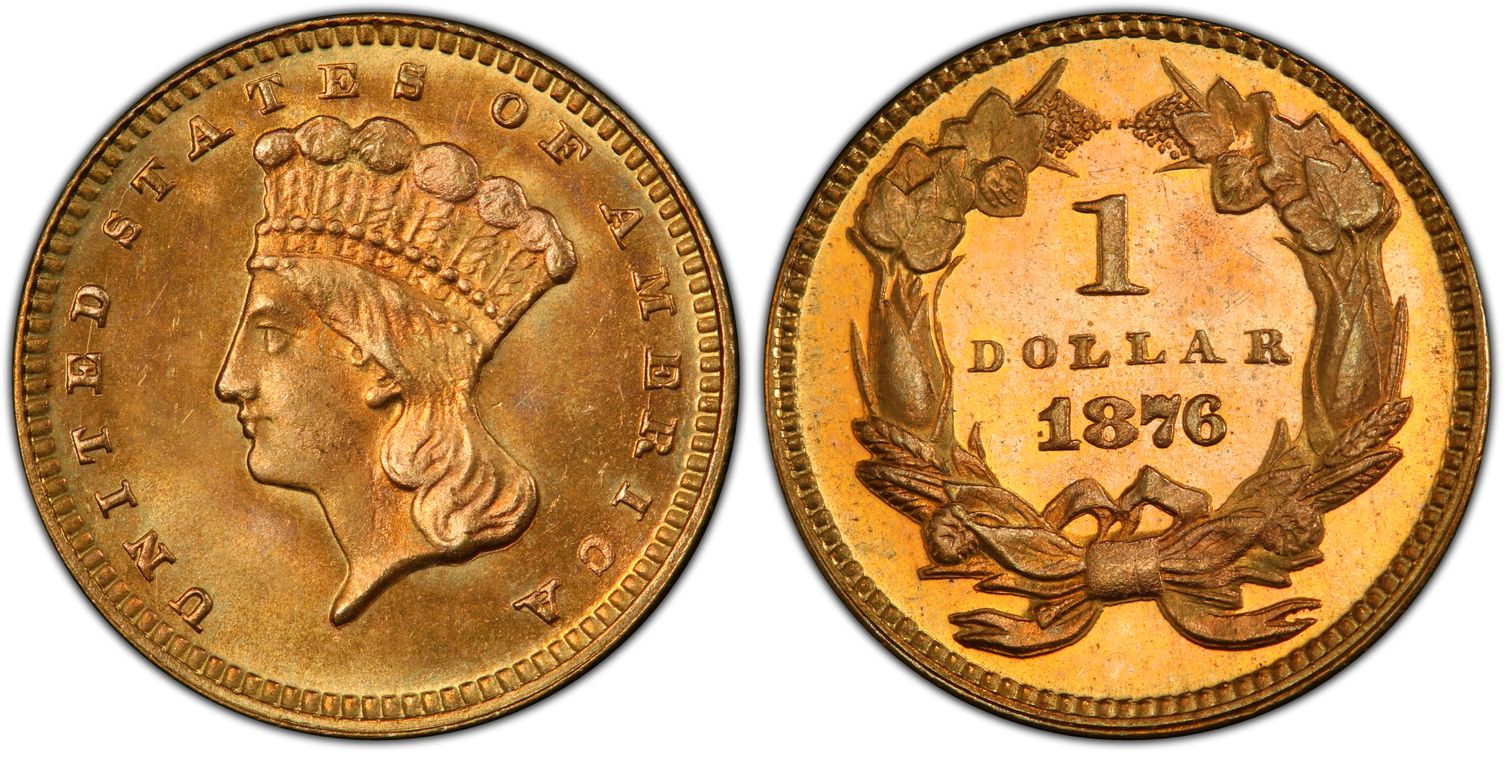Unveiling the 1876 Gold Dollar Type 3 Coin – A Magnificent Collectible of Numismatic Rarity
Disclaimer: Accurate Precious Metals is not a financial advisor. We encourage everyone to consult a financial advisor or CPA. They can help determine the best investment strategies. Our mission is to provide educational content about precious metals. Accurate Precious Metals is committed to transparency and reliability. They offer top-tier precious metal products and information.
The 1876 Gold Dollar Type 3 Coin stands as a significant piece of history and a highly coveted item among numismatists. This article delves deep into the fascinating world of this rare coin, explaining its background, unique features, and why it remains a prized collectible today. Whether you’re a seasoned coin collector or a numismatic novice, this post offers invaluable insights into the 1876 Gold Dollar Type 3 Coin.
Outline
- What Makes the 1876 Gold Dollar Type 3 Coin Unique?
- The Historical Context of the 1876 Gold Dollar
- Design and Symbolism of the 1876 Gold Dollar Type 3
- The Role of James B. Longacre in U.S. Coin Design
- Production Details at the United States Mint
- Grading and Certification by NGC and PCGS
- Why is the 1876 Gold Dollar Type 3 Coin Rare?
- Investment Prospects for the Gold Dollar Coin
- Auction Results and Market Trends
- Frequently Asked Questions
What Makes the 1876 Gold Dollar Type 3 Coin Unique?
The 1876 Gold Dollar Type 3 Coin has various attributes that set it apart in the realm of numismatics. This coin, with its unique Indian Head design and rich historical significance, represents a tangible connection to the American past. Minted during a transformative period in U.S. history, it stands out for its intricate design and the artistry that went into its creation. The obverse features an Indian Head design, while the reverse showcases a wreath, both meticulously crafted to represent American ideals and prosperity.
The 1876 Gold Dollar is notable for its lower mintage compared to other periods, making these coins more difficult to find and thus highly desirable. Collectors value certified examples. The top entities are the Numismatic Guaranty Corporation (NGC) and the Professional Coin Grading Service (PCGS). They make coins more valuable.
The Historical Context of the 1876 Gold Dollar
The year 1876 holds a special place in American history, marking the centennial of the United States. It’s also a year rememberable for the publication of Mark Twain’s “The Adventures of Tom Sawyer,“ a novel that captured the spirit of American youth and adventure. The United States Mint also played a big role in coinage. It continued its legacy of making gold dollar coins. It started this practice in the early 1850s during the California Gold Rush.
These gold dollars served not just as currency but as symbols of American prosperity and innovation. The Mint operated in various locations, including Philadelphia and Dahlonega. They made these coins to show America’s growing economic power. The 1876 Gold Dollar Type 3 coin encapsulates this vibrant history through its existence.
Design and Symbolism of the 1876 Gold Dollar Type 3
The design of the 1876 Gold Dollar Type 3 is a testament to the craftsmanship and symbolism that characterized the U.S. coinage of the era. The obverse features an elegant portrait of Lady Liberty, portrayed as an Indian Princess, a design conceived by James B. Longacre, the Chief Engraver of the United States Mint at the time. This depiction showcases an amalgamation of American and classical imagery, reflecting a nation’s ideals and aspirations.
On the reverse, the coin exhibits an elaborate wreath encircling the denomination and the coin’s date. The wreath design is rich with symbolism, representing unity, peace, and prosperity—core values during a period of reconstruction and growth for the nation. The intricate designs of both sides enhance the coin’s allure among collectors and history enthusiasts alike.
The Role of James B. Longacre in U.S. Coin Design
James B. Longacre made a lasting impact on U.S. coinage through his innovative designs, including the one featured on the 1876 Gold Dollar Type 3 coin. Longacre was the Chief Engraver at the United States Mint from 1844 to 1869. He made some of the most iconic coin designs in American history, including the famous Indian Head cent and the Liberty Head designs on various coins.
Longacre’s influence went beyond looks. His designs often had deep symbolism, reflecting the politics and culture of the time. The Indian Head on the 1876 Gold Dollar Type 3, for example, signifies America’s rich cultural heritage and enduring spirit. Longacre’s work remains a benchmark in the world of numismatics, appreciated by collectors for its artistic merit and historical significance.
Production Details at the United States Mint
The production of the 1876 Gold Dollar Type 3 took place in multiple facilities of the United States Mint, including Philadelphia. Coinage in that era required considerable skill and precision. Every coin had to meet specific standards for weight, diameter, and gold content, ensuring its reliability as a medium of exchange.
These coins were minted using a blend of manual and mechanized processes, combining human art with new technology. The United States Mint used careful quality control to keep the coins consistent and real. This work helped create the high standards we see in these coins today.
Grading and Certification by NGC and PCGS
Grading and certifying a coin like the 1876 Gold Dollar Type 3 adds substantial value and trust within the numismatic community. Institutions like the Numismatic Guaranty Corporation (NGC) and the Professional Coin Grading Service (PCGS) use strict criteria. They use them to assess the condition and authenticity of each coin. These organizations provide a certification that assures collectors of the coin’s quality and genuineness.
An NGC or PCGS certified 1876 Gold Dollar Type 3 coin undergoes a thorough examination, including scrutiny of its front and back designs, mint mark, and overall condition. Certified coins often come with a detailed report that records their grade and unique features. This report becomes part of a large numismatic database used by collectors worldwide.
Why is the 1876 Gold Dollar Type 3 Coin Rare?
Several factors contribute to the rarity of the 1876 Gold Dollar Type 3 coin. Firstly, the minting volume in that year was relatively low, resulting in fewer coins available for collectors today. The historical era also saw gold coins being melted down for various reasons, reducing the number of existing specimens even further. This scarcity adds to the coin’s allure and value.
Additionally, coins that have been preserved in excellent condition, free from significant wear and tear, are even rarer. High-grade examples certified by institutions like NGC and PCGS command high premiums in the marketplace. Collectors actively seek these rarities to add to their collections. This adds to the coin’s lasting desirability.
Investment Prospects for the Gold Dollar Coin
The 1876 Gold Dollar Type 3 coin holds substantial appeal not only for its historical and numismatic value but also as an investment asset. Precious metals like gold have historically served as a hedge against economic uncertainty, and numismatics adds a layer of value. The limited supply of these coins, coupled with their historical significance, makes them an attractive option for long-term investment.
Investing in rare coins such as the 1876 Gold Dollar Type 3 offers diversification for one’s portfolio, providing both tangible and historical value. Accurate Precious Metals, a trusted dealer in precious metals, can assist investors in acquiring these valuable coins. Their expertise ensures that you are making informed decisions and adding quality assets to your investment portfolio.
Auction Results and Market Trends
Auction results and market trends provide a clear picture of the 1876 Gold Dollar Type 3 coin’s value and popularity. Recent auctions have seen these coins fetch high prices, reflecting their desirability among collectors and investors. Auction houses often emphasize the coin’s history, condition, and certification, driving competitive bidding.
The market for such rare coins remains robust, with demand consistently outpacing supply. As more collectors enter the numismatic marketplace, the value and prestige of owning a coin like the 1876 Gold Dollar Type 3 continue to rise. Staying informed on market trends and recent auction results can help collectors and investors. They can make strategic decisions about their numismatic assets.
Important Points to Remember
- The 1876 Gold Dollar Type 3 Coin is highly valued for its rarity and historical significance.
- Designed by James B. Longacre, the coin features an Indian Princess on the obverse and a symbolic wreath on the reverse.
- Grading and certification by NGC and PCGS significantly enhance the coin’s market value.
- The coin’s dimensions are approximately 15 millimeters in diameter and 1.67 grams in weight.
- Historical context, including the California Gold Rush, profoundly influenced the coin’s production.
- Accurate Precious Metals is a reliable source for investing in gold and silver products.
Frequently Asked Questions
Q: What is the significance of the 1876 Gold Dollar Type 3 Coin?
A: The 1876 Gold Dollar Type 3 Coin, designed by the mint’s chief engraver James Barton Longacre, is a notable piece due to its rarity and historical significance. It is the smallest regular-issue gold coin in U.S. history.
Q: What is the mintage of the 1876 Gold Dollar Type 3 Coin?
A: The 1876 Gold Dollar Type 3 Coin’s mintage was relatively low, which contributes to its rarity and value among collectors today.
Q: How can I find the current value of my 1876 Gold Dollar Type 3 Coin?
A: You can find the current value of your 1876 Gold Dollar Type 3 Coin by consulting sources like the PCGS Price Guide and the NGC Price Guide. These resources provide comprehensive coin information and estimated market values.
Q: What are the characteristics of a Type 3 Gold Dollar?
A: The Type 3 Gold Dollar, also known as the “Head Gold Dollar,“ features the image of Lady Liberty on the obverse and was issued from 1856 to 1889. Its small size and intricate design make it a unique and desirable coin for collectors.
Q: What makes the 1876 Gold Dollar Type 3 Coin a valuable addition to a collection?
A: The 1876 Gold Dollar Type 3 Coin is valuable due to its historical significance, the dollar’s tiny size, the low mintage, and its exceptional condition. It is also sought after for its rarity and the craftsmanship of the mint’s chief engraver.
Q: How does the coin’s small size impact its demand and value?
A: The coin’s small size makes it a unique piece in the history of U.S. currency. Despite its size, it represented a significant value (equivalent to a full day’s wages at the time), which increased its desirability among collectors.
Q: Can you add details about the condition and grading of the coin?
A: The condition and grading of the 1876 Gold Dollar Type 3 Coin can vastly affect its value. Coins in mint condition, especially those that achieve high grades from organizations like NGC and PCGS, are more valuable. The NGC Census and NGC Coin Explorer provide detailed grading information and historical context.
Q: What sets the Type 3 Gem apart in the Gold Dollars category?
A: The Type 3 Gem in the Gold Dollars category is distinguished by its excellent condition and visual appeal. Coins graded as “Gem“ exhibit minimal wear and are highly sought after by collectors for their superior quality and rarity.
Q: Why might coin buyers and sellers seek a CAC-certified 1876 Gold Dollar Type 3 Coin?
A: Coin buyers and sellers may seek a CAC-certified 1876 Gold Dollar Type 3 Coin. CAC certification adds an extra layer of quality assurance. CAC stickers are given to coins that meet high standards for eye appeal and technical grading, further enhancing their marketability and value.
 Have a question?
Have a question?